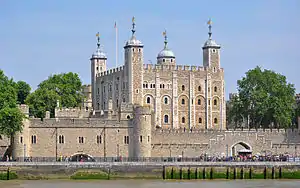Liberties of the Tower of London
The Liberties of the Tower, or the Tower Liberty, was a liberty around and including the Tower of London.
| Liberties of the Tower of London Tower Liberty | |
|---|---|
| Liberty | |
 The Tower of London | |
| Area | |
| • Coordinates | 51.5080°N 0.0762°W |
| Population | |
| • 1831 | 4,190 |
| History | |
| • Abolished | 25 June 1894 |
| Government | Tower Liberty Quarter Sessions |
| • Type | Quarter sessions court |
| • HQ | Court House, Wellclose Square |
| Subdivisions | |
| • Type | Places |
| • Units |
|
It was outside the jurisdiction of the City of London and the County of Middlesex, with its own county government. The area of the liberty expanded in 1686. It became part of the County of London in 1889, and was dissolved in 1894, with the area now forming part of the London Borough of Tower Hamlets.
History
The liberty originally consisted of the area inside the walls of the Tower of London (also known as Tower Within) and immediately outside it (known as Old Tower Without). The boundaries were presented by a Leet Jury in 1525, and again as surveyed by Haiward and Gascoyne in 1597.[1]
In 1686, letters patent granted by James II added the Old Artillery Ground, Little Minories and the Liberty of Wellclose. These areas had come into the possession of the Crown when the religious houses that formerly administered them were dissolved. They were subsequently used for the storing of ordnance.
The population was 3,995 in 1811 and 4,190 in 1831.[2]
Governance

The liberties had an administration separate from the neighbouring county and city, headed by the Constable of the Tower of London, and appointed their own coroner, and had their own courthouse with general and quarter sessions and gaol. A force of constables was appointed for the area. The inhabitants had certain other privileges such as being able to claim any beast that fell from, and any swans under, London Bridge.
From 1837, the liberty formed part of the Whitechapel Poor Law Union. Extra-parochial places were progressively eliminated and following the Extra-Parochial Places Act 1857, the Tower of London and Old Tower Without became civil parishes in 1858. The Old Artillery Ground became a civil parish in 1866, following the Poor Law Amendment Act 1866.
From 1855, the area became part of the Whitechapel District and was administered by the Whitechapel District Board of Works. The liberty became part of the County of London in 1889.[3]
Abolition
The liberty had become obsolete by 1889; it was thought that the Local Government Act 1888 had removed the jurisdiction of the justices. However, the charter was found to be still in operation.[4] The liberty was abolished on 25 June 1894, following a petition by the justices of the peace of the County of London under the Liberties Act 1850.[5]
The area of the former liberty was included in the Metropolitan Borough of Stepney in 1900.
The liberty continued as a franchise coroner's district. The Coroners (Amendment) Act 1926 provided that the district could be dissolved when a vacancy arose; when a vacancy occurred on 10 May 1939, an order was made on 30 November 1939 combining it with the east district. This came into effect on 1 January 1940.[6]
The area of the former liberty became part of the new London Borough of Tower Hamlets in 1965; following boundary changes around the Minories in 1994, small parts are now in the City of London.[7]
Modern Legacy
The history of the liberty is still recognised in an annual ceremony of 'Beating the Bounds' organised jointly by The Tower authorities and the local parish of All Hallows by the Tower every Ascension Day.[8][9] It is also referred to in the name of the large 'The Liberty Bounds' public house founded in an old bank building on Tower Hill and run by the Wetherspoons chain.[10]
References
- "Tower Chambers - Traitors' Bridge - A Dictionary of London (1918)". www.british-history.ac.uk.
- Accounts and Papers, Eighteen Volumes, 17, Relating to Assessed Taxes, Poor, &c, Vol. XLIV, (1832)
- F. A. Youngs, Guide to Local Administrative Units of England, Volume I, London 1979
- TOWER OF LONDON, Star, Issue 5033, 20 August 1894, Page 3
- "No. 26511". The London Gazette. 11 May 1894. pp. 2769–2770.
- http://www.london-gazette.co.uk/issues/34754/pages/8326/page.pdf
- "The City and London Borough Boundaries Order 1993". www.legislation.gov.uk.
- http://calendarcustoms.com/articles/london-beating-the-bounds/
- https://www.ahbtt.org.uk/whats-on/beating-the-bounds/
- https://www.jdwetherspoon.com/pubs/all-pubs/england/london/the-liberty-bounds-tower-of-london
External links
- Map of the Tower Liberties, 1720
- Tower Liberties East of London Family History Society